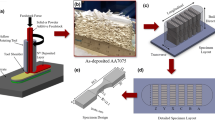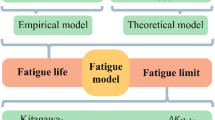Abstract
Additively manufactured (AM) materials experience shorter fatigue lives compared to their wrought form. Shorter fatigue life can be related to different effects like defects, residual stresses, surface finish, geometry, size, layer orientation, and heat treatment. One of the main contributors to the shorter fatigue life of AM alloys is their unique and complex microstructure. In this paper, we study this challenge from a novel perspective in which the interaction between the microstructure and fatigue life is explored. Among different microstructural features in the AM alloys, here we focus on the cells which form inside the grains during fabrication. While this microstructural feature is not always the prominent site for the fatigue initiation, it always has a significant role in the fatigue failure, particularly in high cycle fatigue because it occupies a high percentage of the volume in the material. A fatigue damage model is developed and verified to predict the life of cellular microstructures present in the AM metal microstructure. It is shown that the life of a cellular microstructure, which is composed of an arrangement of cells and cell boundaries is lower than a single-phase material without such an arrangement. We investigate how the arrangement if cells can govern the fatigue life, and analyze different cellular geometries to find the best performing cellular microstructure. By changing the geometrical parameters, the considerable variation in life can be as high as 95% in some strain amplitudes. Since the microstructure of cells in AM alloys can be tailored by changing the processing parameters, our results can be used as a guide to additively manufacture alloys with improved fatigue-resistance.











Similar content being viewed by others
References
D. Herzog, V. Seyda, E. Wycisk, and C. Emmelmann, Additive Manufacturing of Metals, Acta Mater., 2016, 117, p 371–392
T. Moritz and S. Maleksaeedi, Additive manufacturing of ceramic components, Additive Manufacturing, J. Zhang and Y.-G. Jung, Ed., Butterworth-Heinemann, Oxford, 2018, p 105–161
T.D. Ngo, A. Kashani, G. Imbalzano, K.T.Q. Nguyen, and D. Hui, Additive Manufacturing (3D Printing): A Review of Materials, Methods, Applications and Challenges, Compos. Part B Eng., 2018, 143, p 172–196
J. Mazumder, J. Choi, K. Nagarathnam, J. Koch, and D. Hetzner, The Direct Metal Deposition of H13 Tool Steel for 3-D Components, JOM, 1997, 49(5), p 55–60
D. Gu, W. Meiners, K. Wissenbach, and R. Poprawe, Laser Additive Manufacturing of Metallic Components: Materials, Processes and Mechanisms, Int. Mater. Rev., 2012, 57(3), p 133–164
M.T. Andani, N.S. Moghaddam, C. Haberland, D. Dean, M.J. Miller, and M. Elahinia, Metals for Bone Implants. Part 1. Powder Metallurgy and Implant Rendering, Acta Biomater., 2014, 10(10), p 4058–4070
X. Ni, D. Kong, W. Wu, L. Zhang, C. Dong, B. He, L. Lu, K. Wu, and D. Zhu, Corrosion Behavior of 316L Stainless Steel Fabricated by Selective Laser Melting Under Different Scanning Speeds, J. Mater. Eng. Perform., 2018, 27(7), p 3667–3677
N. Shamsaei, A. Yadollahi, L. Bian, and S.M. Thompson, An Overview of Direct Laser Deposition for Additive Manufacturing; Part II: Mechanical Behavior, Process Parameter Optimization and Control, Addit. Manuf., 2015, 8, p 12–35
A. Yadollahi and N. Shamsaei, Additive Manufacturing of Fatigue Resistant Materials: Challenges and Opportunities, Int. J. Fatigue, 2017, 98, p 14–31
L. Bian, S.M. Thompson, and N. Shamsaei, Mechanical Properties and Microstructural Features of Direct Laser-Deposited Ti-6Al-4V, JOM, 2015, 67(3), p 629–638
W.E. Frazier, Metal Additive Manufacturing: A Review, J. Mater. Eng. Perform., 2014, 23(6), p 1917–1928
A. Fatemi, R. Molaei, J. Simsiriwong, N. Sanaei, J. Pegues, B. Torries, N. Phan, and N. Shamsaei, Fatigue Behaviour of Additive Manufactured Materials: An Overview of Some Recent Experimental Studies on Ti-6Al-4V Considering Various Processing and Loading Direction Effects, Fatigue Fract. Eng. Mater. Struct., 2019, 42(5), p 991–1009
A. Yadollahi, N. Shamsaei, S.M. Thompson, A. Elwany, and L. Bian, Effects of Building Orientation and Heat Treatment on Fatigue Behavior of Selective Laser Melted 17-4 PH Stainless Steel, Int. J. Fatigue, 2017, 94, p 218–235
A. Yadollahi, M.J. Mahtabi, A. Khalili, H.R. Doude, and J.C. Newman, Jr., Fatigue Life Prediction of Additively Manufactured Material: Effects of Surface Roughness, Defect Size, and Shape, Fatigue Fract. Eng. Mater. Struct., 2018, 41(7), p 1602–1614
R. Molaei, A. Fatemi, N. Sanaei, J. Pegues, N. Shamsaei, S. Shao, P. Li, D.H. Warner, and N. Phan, Fatigue of Additive Manufactured Ti-6Al-4V, Part II: The Relationship Between Microstructure, Material Cyclic Properties, and Component Performance, Int. J. Fatigue, 2020, 132, p 105363
S. Romano, A. Brückner-Foit, A. Brandão, J. Gumpinger, T. Ghidini, and S. Beretta, Fatigue Properties of AlSi10Mg Obtained by Additive Manufacturing: Defect-Based Modelling and Prediction of Fatigue Strength, Eng. Fract. Mech., 2018, 187, p 165–189
A. Ahmadi, R. Mirzaeifar, N.S. Moghaddam, A.S. Turabi, H.E. Karaca, and M. Elahinia, Effect of Manufacturing Parameters on Mechanical Properties of 316L Stainless Steel Parts Fabricated by Selective Laser Melting: A Computational Framework, Mater. Des., 2016, 112, p 328–338
M.T. Andani, R. Dehghani, M.R. Karamooz-Ravari, R. Mirzaeifar, and J. Ni, Spatter Formation in Selective Laser Melting Process Using Multi-laser Technology, Mater. Des., 2017, 131, p 460–469
M.T. Andani, R. Dehghani, M.R. Karamooz-Ravari, R. Mirzaeifar, and J. Ni, A Study on the Effect of Energy Input on Spatter Particles Creation during Selective Laser Melting Process, Addit. Manuf., 2017, 20, p 33–43
M.T. Andani, M. Ghodrati, M.R. Karamooz-Ravari, R. Mirzaeifar, and J. Ni, Damage Modeling of Metallic Alloys Made by Additive Manufacturing, Mater. Sci. Eng. A, 2019, 743, p 656–664
M.T. Andani, M.R. Karamooz-Ravari, R. Mirzaeifar, and J. Ni, Micromechanics Modeling of Metallic Alloys 3D Printed by Selective Laser Melting, Mater. Des., 2018, 137, p 204–213
F. Xie, Q. Chen, J. Gao, and Y. Li, Laser 3D Printing of Fe-Based Bulk Metallic Glass: Microstructure Evolution and Crack Propagation, J. Mater. Eng. Perform., 2019, 28(6), p 3478–3486
K.G. Prashanth and J. Eckert, Formation of Metastable Cellular Microstructures in Selective Laser Melted Alloys, J. Alloy. Compd., 2017, 707, p 27–34
K. Saeidi, X. Gao, Y. Zhong, and Z.J. Shen, Hardened Austenite Steel with Columnar Sub-Grain Structure Formed by Laser Melting, Mater. Sci. Eng. A, 2015, 625, p 221–229
D. Wang, C. Song, Y. Yang, and Y. Bai, Investigation of Crystal Growth Mechanism During Selective Laser Melting and Mechanical Property Characterization of 316L Stainless Steel Parts, Mater. Des., 2016, 100, p 291–299
Y.M. Wang, T. Voisin, J.T. McKeown, J. Ye, N.P. Calta, Z. Li, Z. Zeng, Y. Zhang, W. Chen, T.T. Roehling, R.T. Ott, M.K. Santala, P.J. Depond, M.J. Matthews, A.V. Hamza, and T. Zhu, Additively Manufactured Hierarchical Stainless Steels with High Strength and Ductility, Nat. Mater., 2017, 17, p 63
Y. Zhong, L. Liu, S. Wikman, D. Cui, and Z. Shen, Intragranular Cellular Segregation Network Structure Strengthening 316L Stainless Steel Prepared by Selective Laser Melting, J. Nucl. Mater., 2016, 470, p 170–178
M. Ghodrati, M. Ahmadian, and R. Mirzaeifar, Modeling of Rolling Contact Fatigue in Rails at the Microstructural Level, Wear, 2018, 406–407, p 205–217
M. Ghodrati, M. Ahmadian, and R. Mirzaeifar, Three-Dimensional Study of Rolling Contact Fatigue Using Crystal Plasticity and Cohesive Zone Method, Int. J. Fatigue, 2019, 128, p 105208
A. Ray and M.-K. Wu, Fatigue Damage Control of Mechanical Systems, Smart Mater. Struct., 1994, 3(1), p 47–58
B. Zhao, F. Shen, Y. Cui, Y. Xie, and K. Zhou, Damage Analysis for an Elastic-Plastic Body in Cylindrical Contact with a Rigid Plane, Tribol. Int., 2017, 115, p 18–27
S.C. Roy, S. Goyal, R. Sandhya, and S.K. Ray, Low Cycle Fatigue Life Prediction of 316 L(N) Stainless Steel Based on Cyclic Elasto-Plastic Response, Nucl. Eng. Des., 2012, 253, p 219–225
A. Vijay and F. Sadeghi, An Anisotropic Damage Model for Tensile Fatigue, Fatigue Fract. Eng. Mater. Struct., 2019, 42(1), p 129–142
Acknowledgment
The authors acknowledge Mr. Matthew Moneghan for his help in preparing the geometrical models for the simulations and Ms. Juanita Stephen for providing SEM images.
Author information
Authors and Affiliations
Corresponding author
Additional information
Publisher's Note
Springer Nature remains neutral with regard to jurisdictional claims in published maps and institutional affiliations.
Rights and permissions
About this article
Cite this article
Ghodrati, M., Mirzaeifar, R. Computational Study of Fatigue in Sub-grain Microstructure of Additively Manufactured Alloys. J. of Materi Eng and Perform 29, 4631–4640 (2020). https://doi.org/10.1007/s11665-020-04935-2
Received:
Revised:
Published:
Issue Date:
DOI: https://doi.org/10.1007/s11665-020-04935-2




